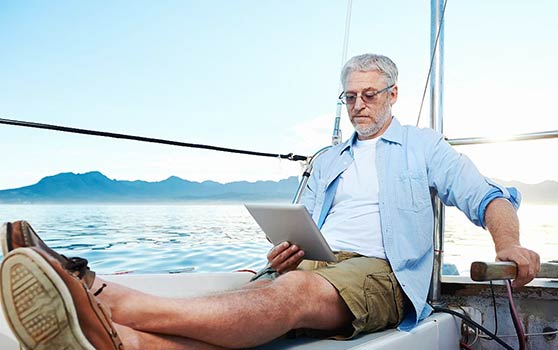For thousands of years, sailors who departed on long sea voyages had to endure long periods of time without any contact with their loved ones. Two hundred years ago, any sailor who crewed on a voyage around the world would be lucky to hear from home once a year. Sometimes they had no contact until the circumnavigation was over and they had made it back home.
In 1914, legendary British explorer Ernest Shackleton left Plymouth, England on a historic expedition to attempt to become the first person to cross Antarctica. World War I had broken out just prior to their departure, but Shackleton received orders to continue with the expedition anyway because British leaders believed that the fighting would be short-lived. Unfortunately, Shackleton’s ship the Endurance was crushed in the ice before he could mount an attempt to sled across Antarctica, and the expedition spent the following two years in a dramatic struggle for survival.
Since there were no reliable long-distance radios aboard ships at the time, Shackleton and his crew were entirely cut off from the outside world. When he finally was able to make contact with a small whaling station on South Georgia Island in May 1916, one of the first questions Shackleton asked was who had won the war. He had been entirely unaware that the battle was still raging as bad as ever. In the end, Shackleton was able to rescue every one of his crew from the ice, but many of them later died when they enlisted in the war upon their return to Europe.
Today, ships are able to receive email and internet at sea through near-instant satellite communication, and shipwrecked sailors are often rescued within hours of setting off their distress beacons. We have come a long way from the time when most communication at sea was in the form of letters carried by ships.
Soon, it will be possible to make a phone call or access the internet from anywhere in the world on a regular cell phone. But we aren’t quite there yet, and satellite communication equipment is still too expensive for many regular cruisers.
Many sailors who are looking for an affordable way to access the internet at sea are interested in the SpaceX Starlink technology. Is it possible to use Starlink to get online from a boat? Keep reading to learn more.
Contents
What is Starlink?
Starlink is a satellite-supported internet service that was created by SpaceX. At the time of writing, Starlink provides internet access to 32 countries, primarily in North America, Europe, and Oceania, although it is their long-term goal to provide global coverage.
Starlink currently consists of 2,400 small satellites in low earth orbit, which communicate with land-based transceivers to provide internet access to their subscribers. Subscribers to Starlink receive a small satellite dish and the necessary hardware to receive an internet connection at their house or boat.
When Starlink announced its plan to develop a truly global, low-cost internet service, many boaters celebrated around the world. Finally, there would be an alternative to the expensive and high-maintenance systems that were currently available to long-range sailors. But how well does Starlink actually work on the high seas?
Will Starlink Work at Sea? How About at Marinas or at Anchor?
Starlink sounds like the perfect solution for offshore sailors who need to get a reliable internet connection at sea for family or work. But unfortunately, at this time Starlink is not adapted for most mobile or marine environments, although it is their intention to eventually offer internet for these applications.
Currently, the Starlink network offers internet to much of North America, but their service doesn’t extend far out to sea. Even if you sail close to shore within their network range, the Starlink dish is designed to find the correct point in the sky to establish a connection only once or twice per day. While at sea on a vessel that is constantly moving and changing direction, the technology will be unable to establish a secure connection. It may be able to temporarily connect while on a straight course, but in general, it will have difficulty keeping up.
What about at anchor? Unfortunately, in most anchorages, your boat will swing with the wind or current and change position too much for the Starlink dish to maintain a reliable connection. So it’s not an ideal solution for use at anchor either.
Despite these restrictions, there are still some cases when Starlink may make sense for use on your boat, even in its current version. In a marina, where your boat is in one location for an extended period of time, Starlink may be a good solution, especially if your marina lacks wifi. Keep in mind that you will need to make sure that there are no obstructions that could prevent the dish from maintaining a strong signal.
Recommended reading: How to Update Your Navionics SD Card by Internet?
How to Use Starlink on Your Boat
If you want to use Starlink on your boat, it’s pretty straightforward to get started. The hardware costs $599, plus $110 per month for the service.
They also recently launched a new service aimed at RV owners that costs $135 per month which can be used in different locations (just not while moving), which is the best option if you plan to use Starlink from different ports.
When you sign up for Starlink service, they will send you all the necessary equipment. The procedure to get started is the same on your boat as it would be in a house or RV. You don’t need to worry about charging, since the equipment connects to your boat’s primary power source. Below is a step-by-step guide to setting it up.
- Download the Starlink app.
- Log in to your account. The app will allow you to check for obstructions and troubleshoot any problems.
- Find a location that is free from any obstructions and set up the Starlink dish.
- Plug the dish into power and connect it to your router. The Starlink will automatically orient itself to search for satellites. After a few minutes, it will make the initial connection to the Starlink constellation.
- On your device, look for the Starlink network and connect to it. Once connected, it will prompt you to enter a new network name and password.
- You are now online!
What are the Benefits and Downsides of Using Starlink?
In its current form, Starlink has many advantages as well as disadvantages, compared to other internet providers. Let’s take a look at some of the pros and cons of using Starlink on your boat.
Pros:
- Starlink is cheaper than many of the alternatives currently available for internet use on boats.
- Easy to set up.
- Coverage is expanding every year.
Cons:
- Equipment isn’t portable or handheld.
- Starlink cannot currently be used while underway.
- Limited coverage along coastlines and almost zero coverage at sea.
- Starlink customers regularly report connectivity issues.
- Requires a clear view of the sky with no obstructions.
What Other Alternatives Are There for Internet at Sea?

So what options are currently available for sailors to get connected offshore? There are three tiers of service currently available, each with its own limitations and price tag. Let’s take a look at the current options:
Tier 1: Handheld Messengers
The cheapest and easiest way to communicate with land from at sea is with a small handheld satellite messenger. This includes devices like the Garmin InReach, Bivy Stick, and Spot Messenger.
These devices can send short text messages to any regular cellphone or email, and some offer other features such as tracking and an SOS button.
Tier 2: Voice and Email
The next step up are devices like the Iridium Go and Satphones, which can be used to make voice calls at sea. The Iridium Go can also receive GRIB weather files and send full-length emails.
Unfortunately, the cost per minute for voice calls through these devices is still extremely high.
Tier 3: Full Internet Access
If you want to get full internet access at sea, you are going to have to pay for it. Companies like Inmarsat and Thrane and Thrane offer satellite internet at sea, but the equipment costs upwards of $10,000, plus thousands of dollars more for the monthly service.
These services are primarily used by commercial vessels and superyachts.
Summary
Starlink is not currently a viable option for sailors who need internet access offshore. But that is likely to change in the near future. Elon Musk, CEO of SpaceX, has stated that it will be “relatively easy” to get boats connected to Starlink. The company has already asked for permission to test its technology at sea, and it has been tested on SpaceX vessels at sea.
A time when sailors can connect to the internet or make a phone call from anywhere in the world at a reasonable price is getting closer every day.
So would I use Starlink on my own boat? For now, probably not. I enjoy sailing offshore, which is currently beyond the reach of their commercially available coverage. Currently, I send messages and receive weather forecasts via my Garmin InReach while at sea.
I look forward to the day that an internet provider like Starlink makes it affordable to use the internet and work online from any place on the planet. But for now, for most sailors, the ocean is still a place to disconnect from the rat race and enjoy the tranquility of nature without Facebook or Google just a click away.
In ten years, it will likely be a very different place.






